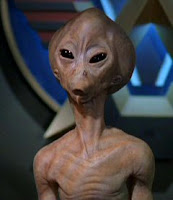
One of the most remarkable things I’ve noticed with the
Stargate SG1 series is the almost decorative design of the
story-arc. Each episode has one but each season also has one and the series as a whole has one as well. The three story-arcs work in unison to develop an intricate weave of plot and
subplot that can be devoured in 42-minute segments.
As you watch from season one through to season ten you notice the major arc, the one that arches over all of the seasons is huge. Episodes become more dramatic, problems compact on top of each other and characters strengths and weakness grow and shift into complex creations that significantly impact the outcome of every choice.

When we start smaller we see the simplicity of a single episode. One central idea/problem is introduced. This problem is always slammed home in the first few minutes, pre opening credits but I’ll talk more about that in Part Four: Hooks, Hangers and the Sequence of Events. We start with what
Les Edgerton (Author of Hooked) called ‘the story-worthy problem’.
This opening scene may or may not involve the main characters but we are always brought to their point-of-view immediately after the opening credits. We see the problem then we backtrack to where the protagonists are right now. They obviously want to solve the problem. As the episode continues they discover that the problem becomes harder to solve, a plausible solution doesn’t work, there are unseen challenges that have to be confronted first, something else happens to compact the situation.
The conflict reaches
climax. It’s a crisis moment and a make or break action tips the scales toward success (or failure). Generally the good guys win against the odds but it is not always in a way that means everyone lives happily ever after (more about this in Part Two: Character Development).

The ending is a rush of released tension BUT we are always a left a few points higher on the y-axis (tension) then when the episode began. There are always questions left unanswered. New elements are introduced that may (or may not) play a significant part in the shows future but always leaves us wondering what is next for these characters. The overall series story-arc is never complete (except, perhaps at the end of the series).
Each season has its own
story-arc as well. When you see the season as a complete picture you recognize that most of that seasons episodes have contributed to the seasons thread. It is often brought to climax in the final episode and often left hanging between seasons so that viewers are left on the edge of their seat with incentive to hold out for the next season during off-season months.
All of these seasons are held together by the solidity of the overall
plot. Questions are introduced that won’t be answered right away. Each of these unanswered questions build upon the plot. The original series worthy problem continues to grow until it too, reaches climax. In fact, it’s often the climax of each season that spikes this major arc over the series to greater heights.
In the overall series plot a number of subplots are woven. These are almost a filler, bulking out the story but also adding elements to enrich the characters and the story as a whole. They stack the odds and continue to develop tension. Sub-plots are often less sub than they originally appear. An alliance formed (or broken) in an earlier episode might seem like a sub-plot but proves to be a significant factor in the major plot events.
 | For Example: In Season 1 Episode 9, Jack and Teal’c come across a recording of Thor in the labyrinth of Thor’s Hammer. In that episode it seems of minor consequence. They’re forced to destroy the Hammer on Cimmeria to rescue Teal’c. The escape from the labyrinth makes up the climax of the episode and we might assume the end of this sub-plot. In Season 2 Episode 6 we discover that the destruction of Thor’s Hammer has a significant impact on Cimmeria and their whole world is put at risk. We discover that Thor isn’t just a recording of a mythical God. In Season 3 we come across Thor again and again and again throughout the series. Thor (and his race, the Asgard) are actually an incredibly important part of the series plot that originated in what seemed like an insignificant sub-plot. |
How does all this relate to our own writing? It throws in to perspective the perfection of the
story arc. We are given the opportunity to monitor the development of the plot (and of subplot) through an intricate construction over a well developed and very successful series. In some books or even movies it can be easy to lose sight of the beautiful design that a plot takes but it is there, underlining every work of fiction. It is a clarified manifestation of the ‘
Beginning, Middle, and End’ concept.
If you’ve ever considered writing a novel or a series of novels it’s important to understand how this structure plays a significant role in your creation. This weave is never perfect in a first draft. To bring the threads together you must pay attention to your story-arc. Weaknesses need to be tightened.
Planning your plot in advance is a great way to develop an idea of how your novels various elements come together but you can also see this to some degree in second drafts. The shaping of your story-arc should be an important part of your editing process.
Labels: Fiction Writing: Plot and Structure, Writing Lessons From Stargate SG1 Series














